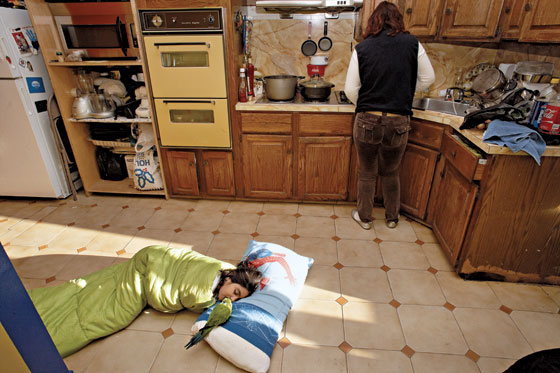
Sitting in his fluorescent-lit kitchen in Sunset Park, Alberto heard the bulletin over Univision: Four days after Barack Obama’s triumph, seven Suffolk County high-school students drove off on a ritual they called “beaner jumping.” Toward midnight by the Patchogue train station they found their man: Marcelo Lucero, 38, a soft-eyed Ecuadoran who worked at a dry cleaner’s, sent pay home to his sick mother, and draped an American flag around his TV set. The teenagers circled Lucero (“like a lynch mob,” a prosecutor said), punched him in the face, stabbed him in the chest, and left him to die in a driveway.
Sixty miles west, Alberto’s thick brows narrowed as he absorbed the news. “It’s like they’re taking target practice. Like they’re hunting an animal.” He winced at the thought of it. “You always think that this could happen to you,” he said. “It could happen anywhere.”
Alberto came to Brooklyn nine years ago from Puebla, followed soon after by his wife, Luisa, and their two children: Berto, a tall and stocky 11-year-old, and Juliana, a year younger and half her brother’s size. In their experience, New York had borne out its reputation as a so-called sanctuary city; diversity made it easy to blend in here. Mexicans accounted for only 21 percent of the half-million or so undocumented immigrants in New York (as compared with 56 percent nationally), according to Jeffrey Passel of the Pew Hispanic Center, with the balance divided mainly among South and East Asians (23 percent), Caribbeans (22 percent), other Latin Americans (19 percent), and Europeans (8 percent). Embedded in multiethnic neighborhoods like Bushwick and Astoria, these newcomers paid taxes and joined church groups; they went out on their senior proms. And city officials recognized their value better than most. “Although they broke the law,” Mayor Bloomberg told the U.S. Senate Judiciary Committee, “our city’s economy would be a shell of itself had they not, and it would collapse if they were deported.”
Of late, though, a storm surge has lapped at the sanctuary’s door. Within the last fourteen months, Eliot Spitzer’s plan to issue driver’s licenses to the undocumented unraveled in a frenzy of xenophobia. Eight miles north of Patchogue, in Farmingville, a hit-and-run driver hopped a sidewalk and struck a day laborer. In September, the sixth Guatemalan in eight years turned up dead in woodsy Mount Kisco—three of them confirmed homicides, and one involving a town cop acquitted of manslaughter. Meanwhile, Lou Dobbs and Bill O’Reilly blame the “alien invasion” for a grab bag of crises: failing schools, fantasy crime waves, outbreaks of leprosy, looming terrorist attacks. Hard-line politicians—like Suffolk County executive Steve Levy—match them stride for stride.
Raids have spiked in suburb and city alike since Immigration and Customs Enforcement (ICE) launched Operation Return to Sender two years ago. In October 2007, in a sting involving the Queens D.A.’s office and the NYPD, a dragnet was thrown over Roosevelt Avenue in polyglot Jackson Heights. Witnesses saw ICE agents scoop up dozens of fenced-in bystanders who looked Latino. Two months later, a unionization vote failed at the Fresh Direct warehouse in Long Island City after a suspiciously timed ICE audit drove hundreds from their jobs.
New York suddenly seemed more like Providence, where nervous Latinos steer clear of the Wal-Mart, or Phoenix, where the sheriff sweeps Hispanic districts into panic. And a recession bodes worse still. Economic crises are doubly cruel to the undocumented. On the one hand, they become more expendable as companies large and small founder; on the other, they serve as handy scapegoats when anxiety runs high.
“New York at one point was impenetrable,” says Marisol Ramos of the New York Immigration Coalition’s youth council, “but now the fear has become very real.” It is stoked by each mass arrest across the country. After ICE swarmed an Iowa meatpacking plant out of Upton Sinclair and handcuffed hundreds of illiterate Guatemalan and Mexican workers, Alberto told me, “You live with that fear—you’re never sure.” It’s why he asked that this story use his family’s middle names. “But you can’t stay home with your hands folded. If you’re going to live like that, why are you here?”
The tension is subterranean, but unremitting. By mayoral executive order, the police are banned from casual questioning about immigration status—but who knows, as Alberto said, “when we’ll bump into a racist cop and he’ll ask for our papers?” And so you’ll see certain dark-skinned people move to the next car when they spot a blue uniform on the subway. They steer clear of hospitals until they are too sick to stand. The undocumented are muted when landlords withhold heat, or bosses refuse to pay, or Feds search their bedrooms without warrants. When you are “out of status,” you learn to keep quiet. To dodge exposure. To stay to work another day.
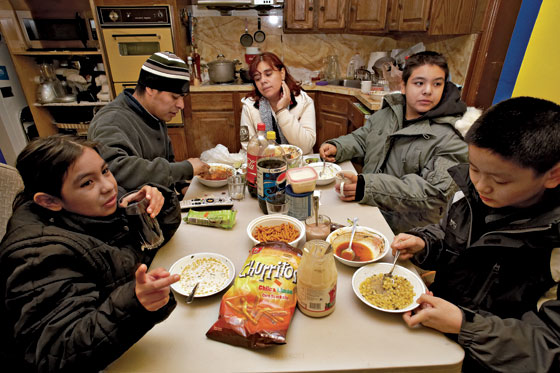
“They live like ghost citizens,” says Kelly Fincham, executive director of the Irish Lobby for Immigration Reform. “They’re here, but they’re not here.”
We met in a freshly swept kitchen where Luisa cooked pozole and tripe soup. It was also the dining room, the living room, the TV room, the computer room, and the study. For meals, a warped plastic table got unfolded, with glasses propped on napkins to keep from sliding. There were two small bedrooms, one with bunk beds for Berto and Alberto’s mother and a small foldout for Juliana, plus a cramped bath. “We’re fine here,” Alberto said. “Not the way we want it, but better than we were before.”
To avoid credit checks, the undocumented rely on the informal—and often illegal—housing market, ranging from cellar dungeons to wildly overcrowded studios. By these standards, the family had done well for their $500 rent, though the furnace was balky in cold weather. It was as close as Alberto could get to his grand obsession, the same goal that had driven Marcelo Lucero to Long Island: to some day own a spacious home. Alberto began building one in Puebla in the mid-nineties, but saw that he’d never finish on his policeman’s salary. In the summer of 1999, after his mother and married sister had settled in Brooklyn, he borrowed $2,800 for a coyote to guide him to Arizona, Los Angeles, and finally New York, where the minimum wage would triple his Mexican income.
While hundreds of migrants die each year in the hellish Sonoran Desert, Alberto’s crossing, by happenstance, was uneventful: five days in a cabin just south of the border, a short hike to a four-foot fence, a waiting van. But in that brief and furtive passage, he crossed a divide that has defined him ever since. He became, as Columbia historian Mae M. Ngai wrote, “a social reality and a legal impossibility … a person who cannot be and a problem that cannot be solved.”
A century ago, a migrant like Alberto could have crossed the open Southwest border as he pleased. Fifty years ago, with immigration still unrestricted within the Western Hemisphere, he might have gained admittance after a head tax and literacy test. Thirty years ago, he would have entered unlawfully and then been rescued by the amnesty of the late eighties. But Alberto joined a later cohort, the surge that followed passage of the North American Free Trade Agreement in 1994. More than anything, NAFTA crystallized a neocolonial conceit: that the U.S. could foster a free flow of trade and capital while freezing Mexican labor in its tracks. The hitch was that people, unlike commodities, moved of their own accord. Unable to compete with subsidized American corn, Mexican farmers lost their livelihoods—and where else could they go? Though Alberto might seem like a classic “target earner,” he did not act in isolation. Millions of the poor have been pushed out of Mexico, and the Border Patrol has yet to build the barrier to stop them. They live outside the law because the jobs here outnumbered the legal pathways. And they formed the critical mass for Alberto’s decision to follow his relatives and try his luck in Brooklyn.
In fairness, there is no real “line” for people like Alberto to wait in: no diversity visas for high-sending countries; no slots for unskilled workers; little practical hope for relatives of U.S. citizens. (For Mexicans, the wait period for family-reunification green cards currently stretches up to 40 years.) Denied legal entry, the people came anyway, often to join legal relatives who came before. As Joseph Salvo of the Department of City Planning puts it, “The documented and the undocumented are sitting across the same table, having dinner every night.”
The government’s conundrum is deep-seated, and its rules schizophrenic. Under immigration law, the undocumented are virtual non-persons. And yet they are covered—in theory—by wage-and-hour laws. They are entitled to emergency Medicaid; their children may attend public schools. With an Individual Taxpayer Identification Number, an “illegal” person in New York can satisfy the IRS, buy a condo, and own a restaurant, all with ICE none the wiser. “The systems are completely non-communicating,” observes Julia Jean-Francois, co-director of the Center for Family Life in Sunset Park. “It’s totally irrational.”
Still, there always lurks the threat of deportation. In the fiscal year ending September 30, ICE removed a record 349,041 people from the United States, many of them severed from jobs and families after a decade or more in this country. Detention centers are crammed with those awaiting ejection; the border bristles with troops and high-tech surveillance, like the old Berlin Wall. In July, a nine-months-pregnant Mexican woman in Nashville got stopped for a ticket and wound up chained to her hospital bed during labor. “We’ve become meaner and meaner on immigration,” says Robert Smith, a sociologist at Baruch and the CUNY Graduate Center and the author of Mexican New York.
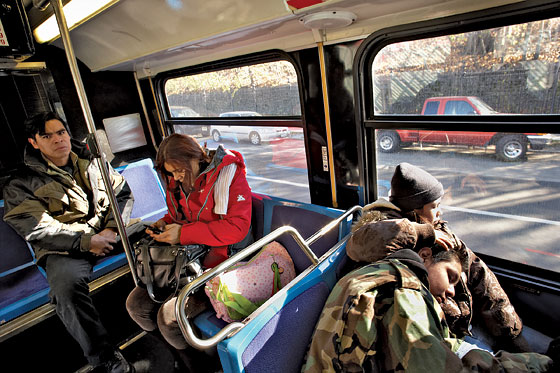
Of late ICE has trumpeted Operation Endgame: the deportation of “all removable aliens” by 2012. Logistically improbable, it would be economically devastating. The country’s 12 million undocumented immigrants underpin agribusiness and home-building. They pay an estimated $7 billion in annual payroll taxes—with no prospect of any return—to the Social Security Trust Fund. Locally, they represent 10 percent of the resident labor force and the backbone of the low-skilled service sector—more than half of New York’s dishwashers, close to a third of its cooks and maids and construction workers, a fifth of its janitors. They wash tower windows and make the school pickups and pack the baby greens picked by unauthorized farm workers. In hard times they preserve our luxuries on the cheap: the $13 manicure, the $50 house cleaning. “They subsidize us in many, many ways,” says Smith. “Have you ever been to Europe and seen how much fruit costs?”
Three days after arriving in Brooklyn, Alberto found a factory job with a burly Israeli (whom we’ll call Jesse) in a dull brick building off the waterfront. Keeping the alias from his crossing, “Oscar” swept up for around $7 an hour. After a year, by watching the others, he learned to make and install custom kitchen cabinets.
Alberto did better than the scrabbling day laborers on Fort Hamilton Parkway, or the supermarket baggers subsisting on tips. He felt safer than those who teetered on off-brand scaffoldings. But he was still exploited in ways typical of undocumented labor. Jesse had seven workers, all unauthorized, all off the books: two Israelis, three Mexicans, one Argentine, one Ecuadoran. While the boss paid as little as he could, it pained him to pay them at all. “He’s very, very tight,’ Alberto said. On Fridays the cash might be a hundred dollars light or weeks late. When he lost patience, Alberto would stop coming to work—a move that backfired the first time, as he had no money and no safety net. Their children in tow, Alberto and his wife gathered cans and hawked tamales from a shopping cart. At their low point, Luisa stood in line, ashamed, at a church pantry.
“You live with that fear— you’re never sure. But you can’t stay home with your hands folded. If you’re going to live like that, why are you here?”
Since then, Alberto had quit and returned to Jesse at least half a dozen times. (“It’s like a bad marriage,” Luisa joked.) The boss was supposed to sponsor him for a green card, but he let it slide and soon the notion became moot as Congress phased out the program in 2001. When a co-worker discovered that Jesse had strung him along, he set his paperwork aflame on the factory floor. Alberto learned a hard lesson: “Nobody here is really going to help you.”
For a time he tried working for himself, picking up construction skills and a small network of contractors. A year ago, he was commissioned to create a home office in cherry wood, making $10,000 over three part-time months. “It’s all me,” he said proudly, leafing through a photo album of sleek panels and clean-shaped moldings. “All this work is my work.” But freelancing proved unreliable, and last January Jesse lured him back for $11 an hour, right around the poverty line, with no health insurance or time-and-a-half. “A temporary thing,” Alberto said, until he found a better offer.
Though he knew where $200 could buy a Social Security number and a forged green card—magic tickets into an aboveground economy—Alberto did not dare make the purchase. While “unlawful presence” is but a civil violation, a fake document can bring down a felony charge. “My children are small,” Alberto said. He was afraid to take the risk.
Immigration is part of the curriculum at P.S. 24, where 9-year-olds freely shared that a parent was mojado—“wet.” But Berto, who came here when he was 3, is so fair-skinned and assimilated that some classmates mistook him for native-born. During last spring’s Diversity Month, he rose with the other foreign-born students, “and my friends said, ‘Wow, I always thought you were Mexican-American.’ I told them I was only Mexican, and half my friends went away. Some kids think that people born outside the border are less important.” On the playground, “Mexican” might be yelled as a put-down, as code for illegal.
As her children edge into preadolescence, “they are realizing the magnitude of their situation,” Luisa said. For Juliana, the practical one, it struck home when her grandmother invited a younger cousin to go to Mexico. “My cousin could go back and forth because she was born here in the United States,” she explained, flicking her straight black hair off her face. “Me and my brother, if we go there, we’re going to have to stay there.”
When asked if she’d heard talk about undocumented immigrants, Juliana cut to the nub: “We probably are unlegal—we don’t have documents to stay here.” Was that a problem? “No and yes. It is a problem for me because I like it here, and my dad could go to jail.”
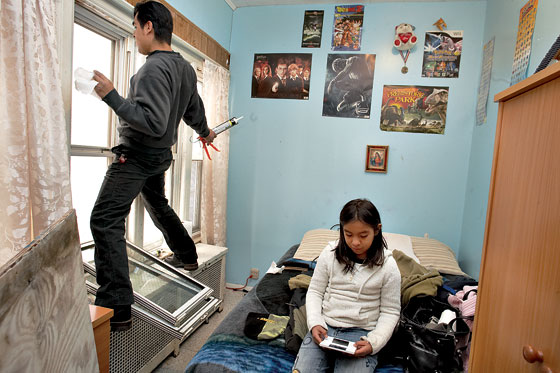
“They treat the immigrants bad,” her brother interjected.
“Yeah, they do,” Juliana said. “I heard they want to pay the immigrants less.”
“I don’t know if I’m a legal or illegal immigrant,” Berto said, “but I’m 100 percent Mexican and I’m proud of who I am.” He was a sensitive boy, eager to please and quick to perceive a slight, but Americanization could be a twisty thing. Berto was in thrall to John Cena, the WWE stalwart and hip-hop artist. One night he showed off a video of Cena hyping his match with a Mexican-American opponent:
I’m about to show you I can whip a Latino,
You run from me like you run from El Niño!
Hot like jala-pee-ño stuck on an enchilada,
I’m a Rottweiler, you’s a Mexican Chihuahua …
You hate me ’cause I’m white, that’s reverse discrimination,
I hate you for two words—illegal immigration!
Cena’s muscular bluster seemed to trump Berto’s ethnic pride—a hint, perhaps, of the boy’s insecurity over his status. After moving to a mostly Latino middle school this fall, he found himself bullied by eighth-graders and reluctant to defend himself. Alberto remembered the times he’d ignored people who provoked him on the street, and his son had asked why. And he had responded, “Because if I hit them, they’ll call the cops and I’ll get deported or locked up.” In an undocumented family, Alberto said, this was something passed from father to son: “You don’t feel you have the right to fight back.”
The immigrant dream is one of sacrifice and deferral; parents slave at lower rungs so their progeny might climb. For children like Berto and Juliana, however, the tale is turned on its head. There are 65,000 undocumented children in New York City, according to the Pew Hispanic Center’s Passel, and their quandary cuts across ethnic lines. (An additional 110,000 are birthright citizens with undocumented parents, a whole other predicament.) Among Latinos, most teenagers leave school early in droves or dive into the workforce after twelfth grade. In families from South Asia, college-educated parents may push their children harder to matriculate. “But whether they finish is another question,” said Monami Maulik, executive director of DRUM, a Jackson Heights advocacy group. “A lot of them drop out the first or second year.”
Like all New York residents, Berto and Juliana will be eligible for in-state tuition at CUNY or SUNY. But they’ll be barred from government grants and loans or paid internships, a sneak preview of the formal job market. One of Maulik’s former Queens youth leaders was a slight 23-year-old named Rajesh, an undocumented Trinidadian of Indian descent. A high-school valedictorian, he began his senior year pointing toward medical school. “I wanted to help people,” he said. “I wanted to be a pediatrician. I like kids.” But that fall, when he needed a Social Security number for some scholarship forms, Rajesh realized he was out of the game. He slogged through premed at Hunter College, going through the motions. “I felt like I wasted a lot of time,” he said. “You want to do good, but what’s the point?” Now 23, he works construction full-time for a family friend.
“These kids are being blamed because they were brought here as children,” said Baruch’s Robert Smith. “It’s a morally upside-down universe.”
A medium-size woman with a smile that channels Meg Ryan, Luisa is a pillar of her Park Slope church and the former secretary of her PTA. At a parent meeting five years ago, she stumped the translator by asking about the “psychometrics” of a standardized test. College-educated, the principal thought. In truth, Luisa drew her knowledge of the world from the Sunset Park branch of the Brooklyn Public Library, where she devoured biographies and monthly issues of Selecciones, the Spanish Reader’s Digest. By last spring she’d begun to see herself as a nurse or a Head Start family worker. But in the next breath she’d sound deflated: “What I like, you need papers for.”
Luisa missed her next YMCA English class, and the one after that. When I caught up with her, she had news: She’d taken a job as a housekeeper and babysitter in Borough Park, five days a week at $10 an hour. As she explained it, the family’s debts had spun out of control the previous summer. With no credit cards available to help make ends meet, they’d borrowed a thousand dollars from a loan shark who charged 10 percent interest per month. Luisa decided that her husband needed help: “Alberto says he’s never going to get old, but I can see his knees hurt when he gets home from work.”
With Luisa covering the food and phone bills, the debts were mostly cleared by June. She rued the loss of her English class when she struggled to speak with her employers. But it made her proud to buy Alberto a camera or surprise Juliana with an American Girl doll on her birthday. The family could breathe a little bit.
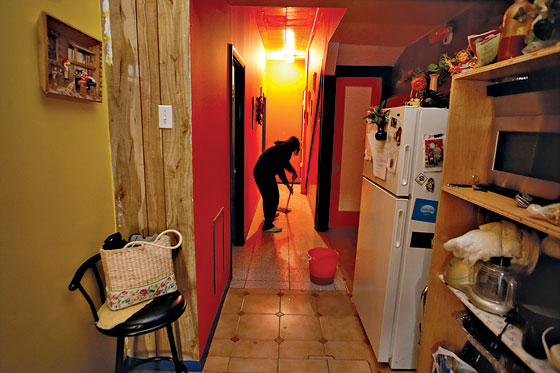
Then the three ladies she worked for informed her that they’d be away for the summer. They would call in September. Luisa was a housewife, and broke, once more.
“Sometimes I don’t know what I want,” she said with a sigh. She missed Puebla’s balmy climate and the freedom of a life lived more out of doors. Most of all she missed her mother, whom she last saw eight years ago. The forced separation clearly weighs on her. On the day I first met the family, I tagged along to a rosary at a friend’s basement apartment. As people talked over chicken and macaroni salad, an empathetic murmur circled the room: Sin papeles. Without papers. The friend’s father had died a few days earlier but it was too risky to go back for the funeral in Acapulco.
The mood was somber as I drove the family home. “This is one sacrifice you make when you are an immigrant,” said Luisa. “If someone dies, we can’t come back.”
In the jungle heat of July, a piercing squawk led Luisa out her front door. On her stoop perched a green parrot. “When a bird comes to your house on its own, it’s good luck,” she said. The parrot was full of tricks, and the children pleaded to keep it. Word had it that a Latino neighbor family had set it free before returning to their country. Now the parrot was undocumented, too.
Under its pale fluorescent glow, the kitchen was livelier than ever. As Juliana swirled to mariachi in her polka-dot folklórico skirt, and the parrot drank iced tea and swayed in time, Berto killed zombies on the computer. Standing at the stove, Luisa stirred a pot with an eye on Fuego en la Sangre, a steamy telenovela. But whole days passed with Alberto missing in action. He was still at Jesse’s factory—still underpaid, still going by “Oscar” for what safety the pseudonym might lend him. One day, on principle, he asked about a long-promised raise to $12 an hour. “I’ll pay you seventeen an hour,” said the boss who’d once pledged to sponsor him, “but bring me your papers.”
To keep pace with his bills, Alberto took a temporary night job and another on the weekends. He’d had no day off for weeks; you could see his fatigue in the worry lines between his eyes. His sole recreation was his Saturday-evening soccer game in Sunset Park, the swath of green that named the neighborhood. At 36, he still looked dangerous with the ball—“I’m a goal-scorer,” he told me, in a moment of braggadocio. His team was rallying when Luisa rushed down the hill on an errand. She returned an hour later with deposits for their weekly tanda, a rotating credit association. For ten weeks each member put in a set amount (in this case, $100); in the eleventh week, he or she skipped a contribution and got the money back. If nothing else, it forced people to save toward the rent or a rainy day.
In an undocumented family, Alberto said, an important lesson is passed from father to son: “You don’t feel you have the right to fight back.”
For Alberto, the ultimate tanda jackpot would be a used Toyota Siena. In Mexico he’d been free, he said. When not out on patrol, he was busing off on some excursion—to see the Provençal colors of Oaxaca or hear the marimbas in Vera Cruz. In New York, he said, he felt entrapado, hemmed-in: “I can’t really move here.” After all this time, he had yet to take his family beyond the city limits. Flying was too pricey and too monitored since 9/11, and everyone knew of the “raids on wheels,” where ICE agents boarded Amtrak or Greyhound and apprehended whole families. Under the circumstances, Alberto’s Toyota lust seemed very American, a longing for the open road.
The catch was that he’d also need a driver’s license, a legal impossibility in New York since 2002. For $3,000, he’d heard that he could get the real deal through a secondhand contact inside the DMV. “I want it, but I’m not sure I’ll really do it,” Alberto said. For now, it’s an extravagance beyond his reach.
When times are bad at the top, they’re generally worse at the bottom. By September, three or four strangers were stopping by the cabinet factory each day, trolling for work. Orders dried up. In the first week of November, Alberto took a call at home; he’d been laid off, effective immediately. For the first time, Jesse had left him. (Characteristically, the boss still owes him $500.) Since then he’s worked construction on and off, but the near future seems grim. Even with Luisa’s wages, the family has ten dollars in the bank.
Now and again Alberto uses Google Maps to zoom in on the project that brought him here. The raw walls of his Mexican house stand like a ruin, a symbol of his life’s incompletion. Though he wants to stay in New York as long as he’s making money and the children keep progressing, who can tell when he might be forced to leave? With a future so abstract, of what use are plans?
But when Alberto looks at his young ones, he knows that they cannot go home again. It’s too hard to picture Juliana’s quirky Brooklyn fashion sense—her fuchsia leg warmers and maroon nail polish—in outer Puebla. Or to see Berto happy where he can’t afford a Whopper or the latest game for his PlayStation Portable. Those who moved to this country before their early teens, the “1.5 generation,” have punched a one-way ticket. “What are they going to do in Guatemala or Mexico or Ecuador?” says Marguerite Lukes of NYU’s Metropolitan Center for Urban Education. “They speak the language, but they’re from a different culture. It would be like immigrating.”
When Berto was born, Luisa says, “I wanted a different life for him. I had this view that he could be what he wanted to be. It was just bigger.” For son and daughter both, she imagined some high profession: “Lawyer, pediatrician, ophthalmologist … ”
“As much as we can give them economically, we’ll help them,” Alberto says. “We’re expecting the best for our children.”
“After something bad,” Luisa says, referring to her own experience as a ninth-grade dropout, “something good has to come.”
Though immigration reform barely surfaced during the fall election campaign, Obama’s intentions might be signaled by his likely choice for secretary of Homeland Security, the department that oversees ICE: Janet Napolitano, the Arizona governor who has backed harsh penalties for those who hire the undocumented while opposing the criminalization of the workers themselves. Advocates dare to hope for a regenerated DREAM (Development, Relief, and Education for Alien Minors) Act, which would give youngsters like Berto and Juliana a route to legalization through either college or military service. “That’s the kissing-babies issue,” Smith says. “I think we’ll probably get something for the kids. The thing for the grown-ups is a whole other fight.”
There is no end in sight for irregular migration, not while half the world lives on less than two dollars a day. Another mass amnesty, tied to a cutoff date, will inevitably sow a new underclass down the road. But the dilemma could be eased, suggests Ngai the Columbia historian, by restoring a statute of limitations for crossing a border or overstaying a visa: “After x years in this country, you’re given a clean slate.” A safe-at-home law would merely bow to a stubborn reality: that, over time, undocumented immigrants raise American families and lay down American roots. That, like it or not, they belong here.
Luisa’s children are still innocent of their tenuous place in the world. The last time I checked, Berto aspired to be either an FBI agent or a singer, while Juliana hoped to teach fourth grade. They recited why their parents crossed over, like a bedtime story they’d yet to outgrow. “My dad’s dream was … ” Juliana said haltingly. “What was his dream, Berto? He told us all of his dreams.”
“To live a better life and raise a family,” her brother said.
Juliana looked pleased: “So that’s why he came, for us to have a better life.” She could not envision living elsewhere, yet she’d begun to intuit her plight. One day she told me, “Some people think immigrants just come to New York to visit, but that’s not always true. Sometimes they come to live their future.”